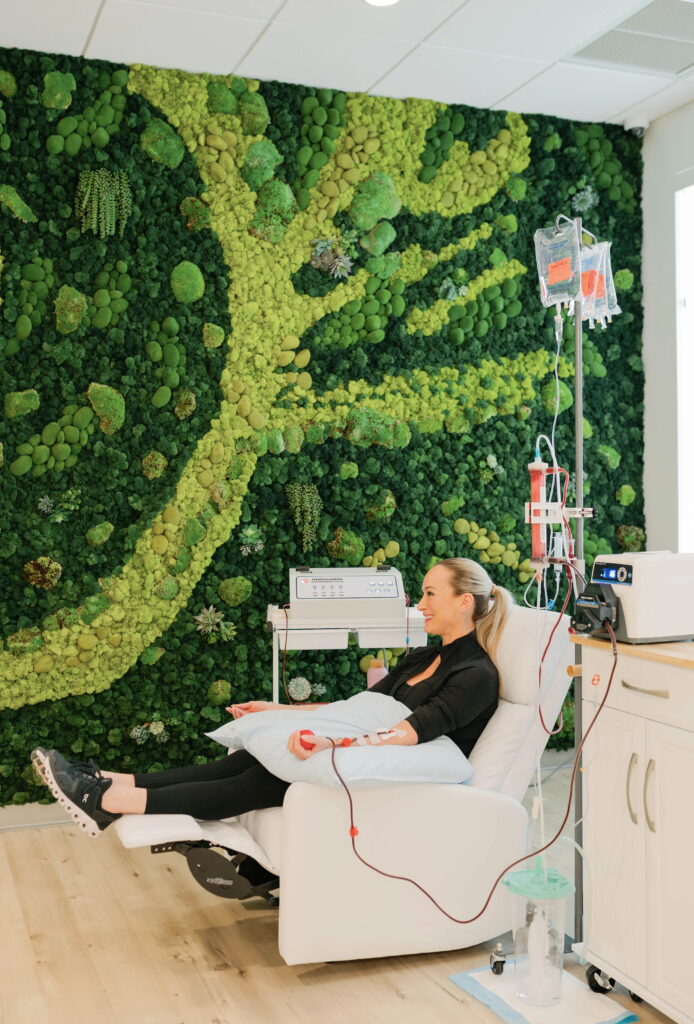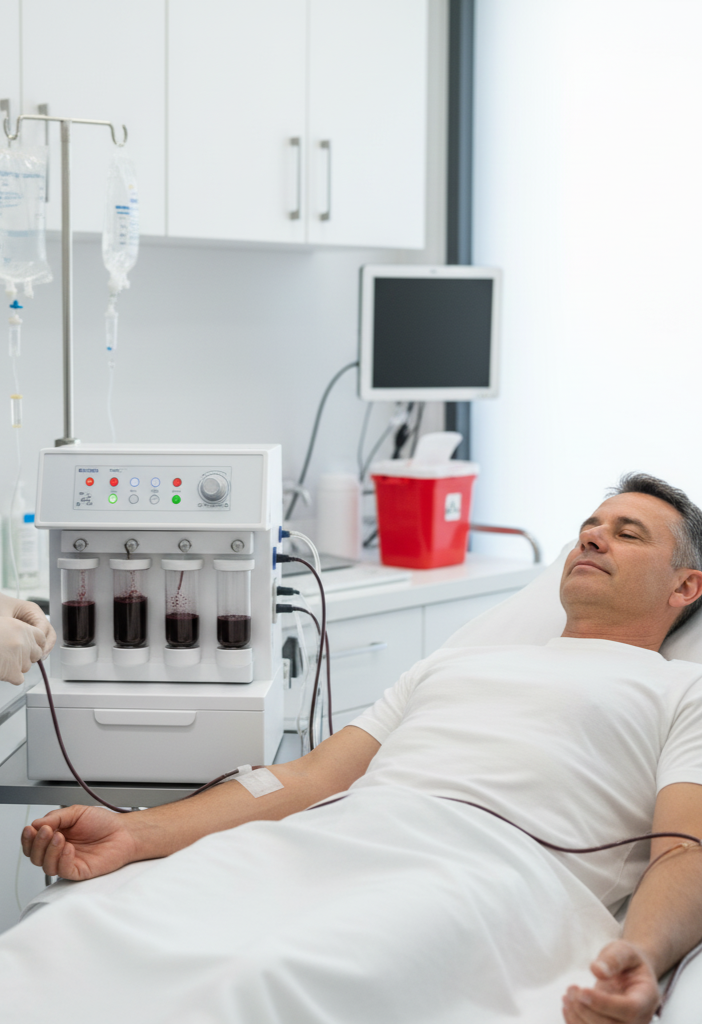Therapeutic Plasma Exchange in Rancho Palos Verdes, CA

Therapeutic plasma exchange (TPE) (also called plasmapheresis or apheresis) is a cutting-edge medical service that refreshes the patient’s plasma (the liquid part of the blood) in order to remove particles that are known contributors to disease and accelerated aging. TPE has the ability to remove toxins and inflammatory agents, supporting the body’s natural rejuvenation processes and improving health outcomes.
Think of this service as an oil change for your health—it’s the perfect way to refresh your system and enhance overall wellness. TPE works by removing harmful substances from the blood’s circulation, helping to cleanse the bloodstream and promote better health. We also offer Ebo2 therapy as part of our comprehensive wellness services. Before and after each TPE session, receive a complimentary Total Baseline Test to assess the effects of the plasma exchange, enabling personalized adjustments for optimal results. *Los Angeles locations only.
What is a Therapeutic Plasma Exchange?
Therapeutic plasma exchange (TPE) is a cutting-edge medical service that refreshes the patient’s plasma (the liquid part of the blood) in order to remove particles that are known contributors to disease and accelerated aging. TPE techniques have evolved significantly over time, with advancements in technology and procedure making the process safer, more efficient, and more effective.
Therapeutic Plasma Exchange at Next Health includes a Total Baseline Test before and after each session. This empowers you to monitor the impact of TPE on your health journey and maximize your results. You can expect the procedure to last between one and three hours, depending on your individual needs and the specifics of your treatment.
How Does Plasma Exchange Work with Replacement Fluid?
Plasma is removed through an IV and centrifuge, which separates plasma from other blood components with the goal of extricating harmful substances such as proteins that cause plaque build-up, autoimmune conditions, arthritis, and even neurodegenerative disorders such as Alzheimer’s disease. Critical components such as red blood cells and immune cells are separated from the plasma, with the remaining blood components returning to the body for healthy functioning. The plasma itself is replaced with a saline, vitamin-packed solution to nourish the body.
Replacement plasma or fluids are obtained from donors or prepared synthetically to ensure safety and compatibility.
The purpose of this replacement therapy is to replace substances that aren’t working properly in your body with ones that are more effective.
TPE is performed under the care of a licensed medical provider and monitored by healthcare professionals. The process will take about 2-4 hours, and can be done on an outpatient basis. The body’s ongoing synthesis of plasma components can influence how often and how effectively TPE needs to be performed.
Benefits of Plasma Exchange
After removal, beneficial components are added back into the body for a variety of potential results:
- Reduce inflammation to counteract aging
- Feel mentally sharp, enhance memory capability, and more
- Support heart health and circulation
- Aid detoxification and elimination of toxins
- Strengthen immunity to stay healthy and get sick less often
- Rejuvenate overall health
Subscribe to our newsletter
Why Would You Need a Therapeutic Plasma Exchange? Complications and Indications
TPE has been used as part of treatment plans for Alzheimer’s disease, inflammatory conditions, chronic viral infections, kidney issues, and more by reducing the protein and harmful components in the body. Over time, these proteins have a compounding effect on the body that contributes to and worsen these conditions. For example, TPE is used in the management of autoimmune diseases such as anti-GBM disease, where rapid removal of pathogenic autoantibodies is crucial.
Now, this service is available to those looking to take a proactive approach to their health as research shows TPE has promising benefits for those looking to live healthier and longer. By reducing and eliminating common contributors to disease with TPE, you are empowered to change the trajectory of your health for the better. Recovery of organ function or clinical improvement is often observed after a minimum duration of treatment, and some patients may notice improvements within a couple of months after starting TPE. However, it is important to note that research findings on TPE effectiveness are sometimes mixed, especially for certain conditions.
Therefore, this service is a great option for anyone aiming to enhance their longevity lifestyle and feel their healthiest. It can especially benefit individuals with:
- Elevated lipoprotein (a) and other lipid levels
- High levels of inflammation
- Family history of neurodegenerative disorders like Dementia
- Transplant scenarios, such as kidney transplant patients, where TPE is used to manage rejection or recurrence of disease
In immune-mediated conditions, steroids are often used alongside TPE to control inflammation, and in some autoimmune diseases, TPE is combined with concomitant immunosuppression to effectively reduce autoantibody levels and prevent rapid rebound. The reasons for choosing TPE in specific clinical scenarios include the need for rapid removal of pathogenic substances to prevent further organ damage.
What Services Should I Do with a Plasma Exchange?
For those interested in TPE, our medical experts recommend maximizing the benefits of this service by adding Stem Cells or Exosomes to your treatment. Once harmful substances are removed from your blood with TPE, it is an excellent opportunity to potentially enhance your cellular communication with these rejuvenating services.
Complications and Management
You know, while Therapeutic Plasma Exchange (TPE) is honestly considered pretty safe and well-tolerated, it’s important to understand that, like any medical procedure, it can sometimes come with certain complications. The most common issues? They usually happen because of changes in your blood volume, like low blood pressure (hypotension), which can occur when plasma gets removed during treatment. You might feel a bit lightheaded or faint, but don’t worry—these symptoms are typically managed by adjusting how fast the plasma removal happens and carefully watching the amount and type of replacement fluid you’re getting.
Another thing that can happen is hypocalcemia, or basically decreased calcium levels in your blood, which is caused by the citrate they use to prevent clotting during the procedure. You might experience some tingling or muscle cramps, but these can be quickly fixed by giving you calcium supplements right during the session. Allergic reactions to replacement fluids, like donor plasma or albumin, can also pop up sometimes. These reactions might range from mild to more serious, but your medical team is totally prepared to handle them by switching to a different replacement fluid or giving you medications as needed.
Less commonly, TPE can lead to blood clots, infection, or bleeding. Blood clots might form in the catheter or blood vessels, but honestly, the risk is kept pretty low by using anticoagulants and keeping a close eye on you. Infections are rare but can happen at the catheter site or in your bloodstream; strict sterile techniques and quick antibiotic treatment help prevent and manage these issues. Bleeding is another possible complication, especially when blood products or anticoagulants are used, but this gets managed by adjusting medication doses or providing platelets and other blood products as needed.
How many TPE treatments will you need? Well, that really varies depending on what disease you’re dealing with and how you respond to the therapy. Some conditions, like thrombotic thrombocytopenic purpura, might require daily treatments at first, while others may only need a few sessions spread over several months. Your treatment plan is always developed together with your healthcare provider, taking into account your specific symptoms, medical history, and whatever underlying disease you’re facing.
TPE is often used alongside other therapies, like immunosuppression with corticosteroids, to boost the effectiveness of treatment for diseases involving autoantibodies or immune complexes. Your medical team, including your physician and other healthcare providers, will work together to make sure your therapy is evidence-based and tailored just for you. The ASFA guidelines provide clear recommendations for when TPE should be started, helping to ensure you get safe and optimal outcomes.
The way TPE works relies on these advanced apheresis machines that use a centrifuge to separate the plasma from your red and white blood cells and platelets. The separated plasma then gets replaced with a suitable fluid—either donor plasma or a synthetic solution—chosen based on what you specifically need. Most TPE procedures happen in an outpatient setting, so you can head home the same day, but you might need inpatient care if you’ve got more complex conditions or severe symptoms.
If you’re interested in participating in clinical trials or research studies, TPE can sometimes be provided as part of these evidence-based investigations. Considering this option? Your healthcare provider can help figure out if you’re eligible and talk through the potential benefits and limitations with you.
In summary, while complications can happen with plasma exchange, they’re generally manageable with prompt attention and expert care. By working closely with your medical team and understanding the principles and safety measures involved, you can feel confident in how effective and safe TPE is as a treatment for a variety of diseases.
Other Services We Offer:

Transform Your Health with EBOO Therapy
Patient with Peripheral Neuropathy regained sensation in their Feet after 1 Year with
EBOO “Oil Change”
Therapeutic Plasma Exchange FAQ
1. How much does therapeutic plasma exchange therapy cost?
At Next Health, Therapeutic Plasma Exchange costs $10,000.
2. How quickly does plasma exchange work?
The speed at which therapeutic plasma exchange yields noticeable results can vary from person to person. However, many individuals report experiencing an increased sense of vitality and overall well-being within a few weeks to a couple of months after undergoing the procedure.
3. What are the benefits of therapeutic plasma exchange?
Therapeutic plasma exchange is designed to offer a multitude of benefits that align with Next Health’s proactive care approach. By removing toxins, inflammatory agents, and potential harmful substances from your bloodstream, this procedure can lead to improved cellular function, increased energy levels, and enhanced vitality. This process supports your body’s innate ability to repair and regenerate, which in turn can contribute to a longer, healthier life. Furthermore, therapeutic plasma exchange can aid in reducing oxidative stress, promoting mental clarity, and strengthening your immune system’s resilience.
4. What is the difference between plasmapheresis and therapeutic plasma exchange?
Plasmapheresis separates plasma from blood, while therapeutic plasmapheresis, or plasma exchange, also eliminates harmful substances from the bloodstream. A catheter connects to a machine that separates blood into components: red and white blood cells, and plasma. Plasma is discarded, and the rest, mixed with a suitable substitute, returns to the circulation.

